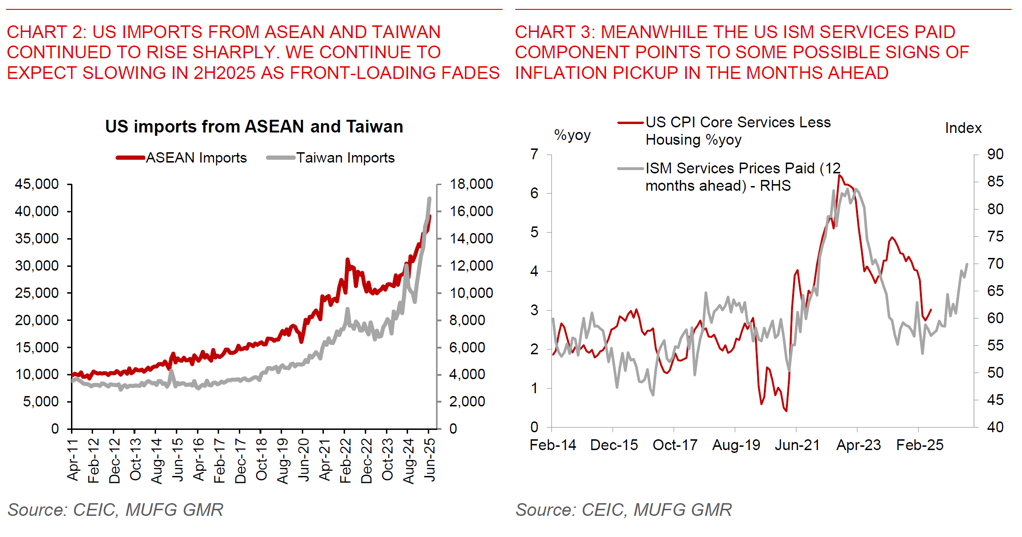Ahead Today
G3: US Mortgage applications
Asia: RBI Policy
Market Highlights
The combination of the macro data from US points to an economy that is slowing somewhat and also initial signs that inflation will continue to pass-through to end-consumers once we move past the initial period tariff announcements. In particular the July ISM Services index moderated to 50.1 from 50.8, with weaker new orders and employment, together with a further increase in the prices paid sub-component. Meanwhile, US goods imports fell by more than 4% in June, led by softer consumer and automotive imports, although capital goods imports picked up during the month. The country divergence was also interesting, with further declines in US imports from the Euro Area – likely reflecting softer pharma and auto imports – but with still very sharp imports increase for several Asian markets including Vietnam, Indonesia, Taiwan and Thailand. All these corroborate the trends we have seen out of Asia’s export, but more importantly also points to the likely unsustainability of the front-loading that is currently taking place. We as such continue to expect some slowdown in Asia’s exports to the US in 2H2025 as inventories start to get drawn down, and from US inflation perspective we expect greater price passthrough in the months to come.

The impact to Asia’s exports from tariffs will also be further compounded by upcoming sectoral tariffs including on semiconductors and pharmaceuticals, which Trump mentioned overnight that he will announce “within the next week or so”, with an initial “small tariff” placed on pharmaceuticals before tariff rates rise to 150%-200% within one to two years. We note that exemptions currently cover around 30-40% of Asia’s exports and in particular concentrated in electronics and pharma, with for instance 60% of Taiwan’s exports to the US not paying tariffs today due to upcoming sectoral Section 232 investigations. Meanwhile, the likes of India and Singapore in Asia have quite sizeable pharmaceutical exports to the US which are currently exempted. The impact to Asia will depend on the product level differentiation in tariffs, and also how important each product is to each country – and these details will be important in gauging the market impact.
The last key global theme relates to President Trump’s continued active intervention in US institutions, not least the Federal Reserve and also other agencies such as the Bureau of Labour Statistics. President Trump overnight said that he has narrowed down the list of Fed Chair candidate to four including “two Kevins” – presumably Kevin Hassett and Kevin Warsh, but that excludes Treasury Secretary Scott Bessent as he has ruled himself out of the running. Trump mentioned that he will decide on Fed opening role by the end of this week.
Looking at Asia, markets will focus on RBI’s policy meeting, and in the context of the higher than expected 25% reciprocal tariffs and also unspecified tariffs on India’s purchase of Russia oil (India-US trade talks and tariffs – Delayed and denied). We think RBI will pause in this meeting but more importantly we see RBI cutting rates by another 50bps – 25bps in October and December – due to the negative growth impact of tariffs.

